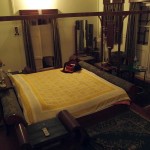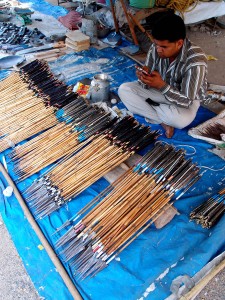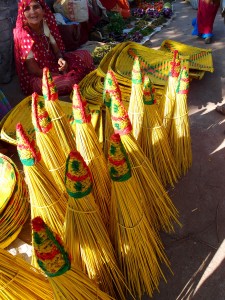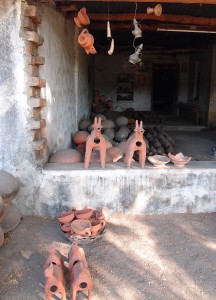Chhota Udaipur
Chhota Udaipur is a quiet town in the eastern Gujarat. We arrived there late after long delays on the road because of celebrations from the victorious BJP in the State elections. Villagers lined the roads to watch conveys of trucks and vans flying flags and carrying supporters.
It was dark by the time we reached Kali Niketan. Built for the grandfather of the current ex-royal at the end of the 19th century, it was renovated throughout in the 1930s and is full of furniture and fittings of that time. The house is pretty fascinating but perhaps on the ramshackle side of atmospheric. I can imagine some people’s reaction being horrified. The Maharaja and his wife live upstairs. The son, a call centre manager is ‘on tour’ in Thailand.
There’s a massive collection of taxidermy; most of it in good shape. It nicely sets off a collection of Disney figurines.One of the living rooms houses four leopard heads, two bears, one whole leopard, one tiger skin, one crocodile and a leopard skin carpet. The other bedroom we viewed had two leopards poised over the bed. I counted the body parts of around 20 leopards.
They’re building some modern bungalows in the grounds; space and ensuite bathrooms. Meals will still be in the house, but some of the atmosphere might get missed.
There’s a delightful family painting downstairs – not that old – of sunglass-wearing family members smiling as they stand over the corpse of a bear. And upstairs, one of the wall-mounted skulls – recent – comes with a WWF sticker attached. Plenty of deco furniture and light fittings, one enormous job lot; one or two pieces are nice but much is very worn and dusty.
The friendly set of retainers were happy to talk about the house and the family. One was born in the compound and had worked here for 35 years. One mentioned: “Snakes do come into the house but not beyond the ground floor”.
The Aide-de-Camp (all the Mahrajahs seemed to have ADCs) showed us around the house. His daughter lives in Bristol and is a Tory councillor for the city council. He proudly showed us a picture of her with David Cameron.
The Haat
 On Saturday it’s Chhota’s turn to host a haat; the weekly market. The tribal people have been walking into town since the early hours. Kim lurks behind the women photographing their bandhani (tie-dyed) saris.
On Saturday it’s Chhota’s turn to host a haat; the weekly market. The tribal people have been walking into town since the early hours. Kim lurks behind the women photographing their bandhani (tie-dyed) saris.
I’ve never seen so many precisely arranged vegetable stalls; beautifully-piled mounds of tomatos, beans and aubergines. We were early, before the crowds, so there was a sense of calmness before the rush.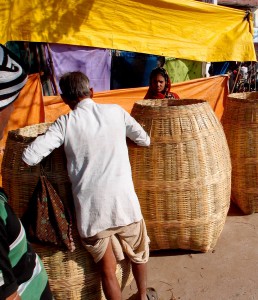
Among the vegetables and clothes there were basket makers and stalls selling bows and arrows – technically illegal – and home-made coils of rope made from some sort of grass fibre or creeper. Cows were forever stealing mouthfuls of horticulture when the stallholders weren’t looking.
The local museum has a collection of artifacts from various tribes. Some, like the bows and arrows, the woven loincloths, the tassled holders for carrying pots on your head, and the rice dehuskers we still on sale in the market we had just visited. There were some great wall paintings, which they really should sell on canvas, and some more elaborate terracotta horses, camels and elephants.
The town has several large and crumbling palaces; the main one is empty and subject to a family dispute over turning it into a hotel. Another is rented out to the Collector. And one is empty and crumbling. Lots of art Deco building around the town and others from earlier colonial times. But also dusty, pig-inhabited and rubbish-strewn open spaces, like most Indian towns.
The Maharaja
We finally met the the Maharaja the second evening and had a number of talks with him over dinner and breakfast. He was sent away to Rajkumar College in Rajkot, the famous royal boarding school where the British encouraged many of the princes to attend. The family had the British Resident over from Baroda every Christmas to shoot panthers in the forested hills north of Chhota. If we ever go back he said he’d take us to the camp. He regretted the break-up of the royal states and the confiscation of property. Personally he missed out going to Cambridge because of the war, He desisted current politicians for their populism and corruption. And he was pessimistic about India; too many people.
But the guy had shot tigers – including the rug downstairs – you don’t often meet people like that. (Caveat; he said he only shot them if they were becoming a nuisance.)
He talked about the burden of looking after six palaces – there are pictures of them up in the hall – but those were the days when you could get a palace built in 28 days and had the railway line go past your front door for your private carriage. One of the palaces apparently had 80 kg of gold incorporated into the building! His son and daughters now have to work in fairly normal jobs, as he had to do after the break-up of the royal states. He regretted democracy and the ignorance of the population yet also saw that the demand for education was leading to labour shortages that were affecting what was left of his estate.
He was great friends with the Maharaja of Morbi. The princes, he said, never met up now – they’re all too busy. He used to have 250 horses and a private army (unclear exactly when this was) and they had a silver carriage. They can’t wear their jewels anymore because the government takes an interest. He’s quite vehemently anti-prohibition; he says smuggling across the nearby Madhya Pradesh border is easy but makes alcohol expensive.
His father and uncles were invited to the coronation (George V) in 1937. They brought back various tea services from Britain and he showed us some ceramics from a locked cupboard; some 19th century stoneware with Gothic ruins and a stylish 1930s set from Shelley’s with the family crest (“Death or victory”).


